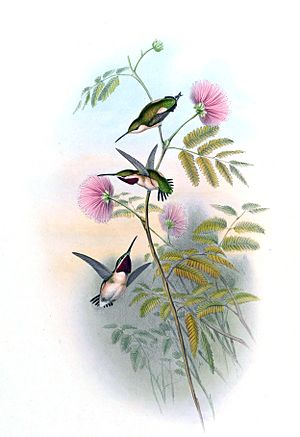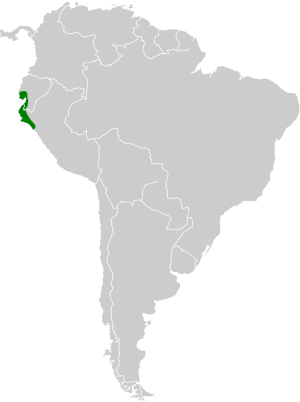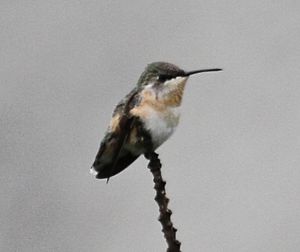Short-tailed woodstar facts for kids
Quick facts for kids Short-tailed woodstar |
|
|---|---|
 |
|
| Conservation status | |
| Scientific classification | |
| Genus: |
Myrmia
|
| Species: |
micrura
|
 |
|
| Synonyms | |
|
Calothorax micrurus |
|
The short-tailed woodstar (Myrmia micrura) is a tiny and beautiful hummingbird. It's known for its very short tail, which gives it its name! This special bird is the only one in its group, called Myrmia. You can find it flying around in Ecuador and Peru.
Contents
About This Hummingbird
This little bird is a type of hummingbird. Scientists first put it in a group called Calothorax. But around 1876, they decided it was unique enough to have its own group, Myrmia. So, the short-tailed woodstar is the only species in the Myrmia genus. It doesn't have any different types or subspecies.
What Does It Look Like?
The short-tailed woodstar is super small! It's about 6 centimeters (2.4 inches) long. It weighs only about 2.3 grams (0.08 ounces). This makes it one of the smallest birds in South America. It has a short, slightly curved black beak.
Both male and female birds have shiny green feathers on their backs.
- Males have a white stripe from their beak to below their eye. Their throat area, called a gorget, is a sparkling violet color. Their chest is white, and their sides are a bit dull. Their very short tail has green feathers in the middle and blackish ones on the sides.
- Females don't have the bright violet throat. Their undersides are a pale, creamy white to a light brown color. Their tail looks like the male's, but the outer feathers have white tips.
Where It Lives
The short-tailed woodstar lives in parts of southern Ecuador. You can also find it in Peru, as far south as the northern La Libertad Department.
Its Home Environment
This hummingbird likes dry, bushy areas. It lives in scrublands, shrublands, and even gardens. It mostly stays in lower areas, close to sea level. In Ecuador, it usually lives below 200 meters (650 feet). But in some areas, it can be found as high as 800 meters (2,600 feet). In Peru, it's usually near the coast. However, it can sometimes be seen up to 1,200 meters (3,900 feet) high.
How It Behaves
Movement and Travel
The short-tailed woodstar usually stays in the same area all year. It doesn't migrate far. However, it seems to move away from the very coastal areas during the rainy season.
What It Eats
This bird eats nectar from flowers. It looks for food at all heights, but often feeds close to the ground. It also eats tiny insects and other small creatures. We don't know all the details of its diet. But it has been seen feeding on flowers from the mallow and pea families. It often visits flowers planted around houses.
Reproduction and Life Cycle
Most of what we know about how short-tailed woodstars raise their young comes from Ecuador. There, the breeding season is mostly from March to May.
- Courtship: Male birds do a special U-shaped flight to attract a mate.
- Nests: Females build a cup-shaped nest. They use soft plant material and spiderwebs. The nest is usually in the fork of a thin branch. It's typically 0.6 to 2.6 meters (2 to 8.5 feet) above the ground.
- Eggs and Young: The female lays two eggs. She sits on them for 15 to 16 days until they hatch. The young birds leave the nest about 22 to 23 days after hatching.
Its Sounds
The male short-tailed woodstar has a sweet, high song. He sings it during his special display flight. It sounds like a series of "tititi" notes mixed with a high "sweee." The bird's regular call is a thin "tchi-tchi-tchi."
Conservation Status
The IUCN (International Union for Conservation of Nature) says the short-tailed woodstar is of "Least Concern." This means it's not currently in danger of disappearing. It lives in a fairly large area. Even though we don't know exactly how many there are, their numbers seem to be stable. It's quite common in Ecuador and somewhat common in Peru. Human activities don't seem to affect it much, at least for now.
See also
 In Spanish: COlibrí colicorto para niños
In Spanish: COlibrí colicorto para niños



